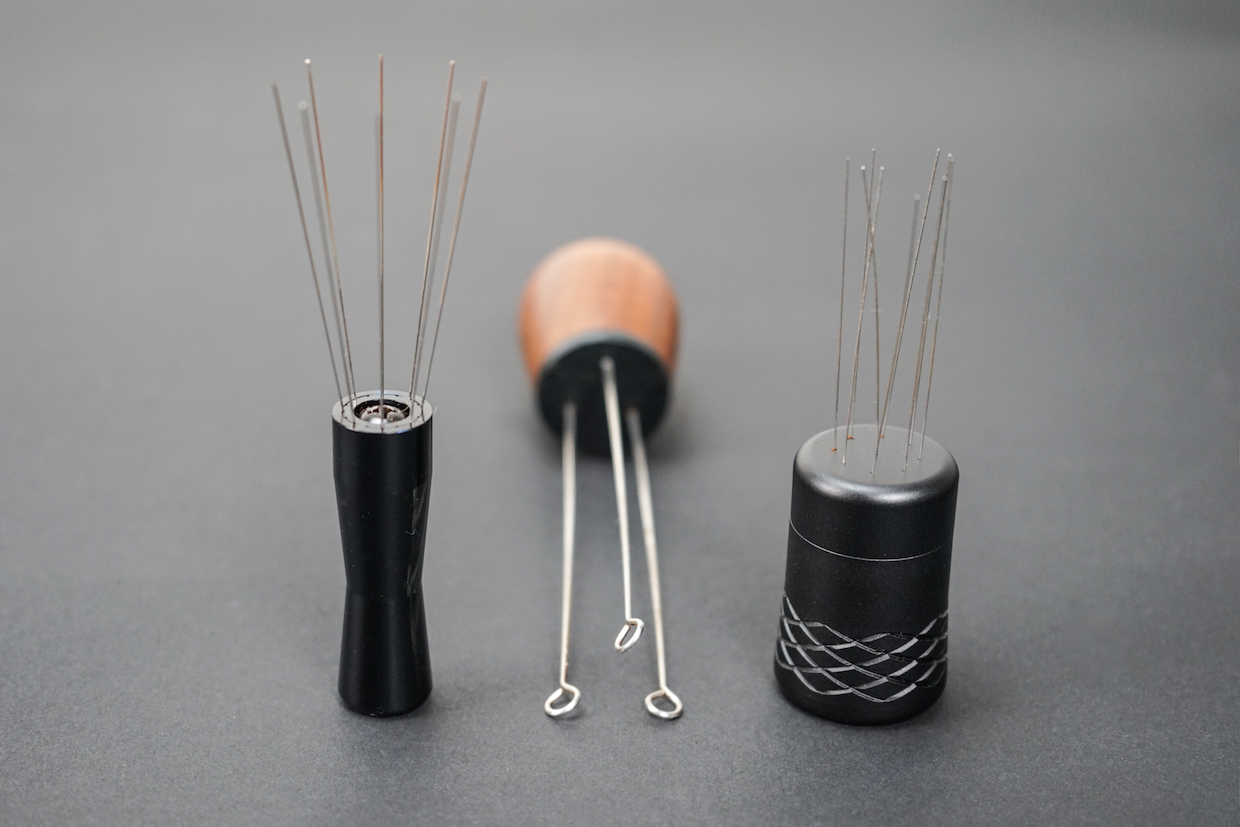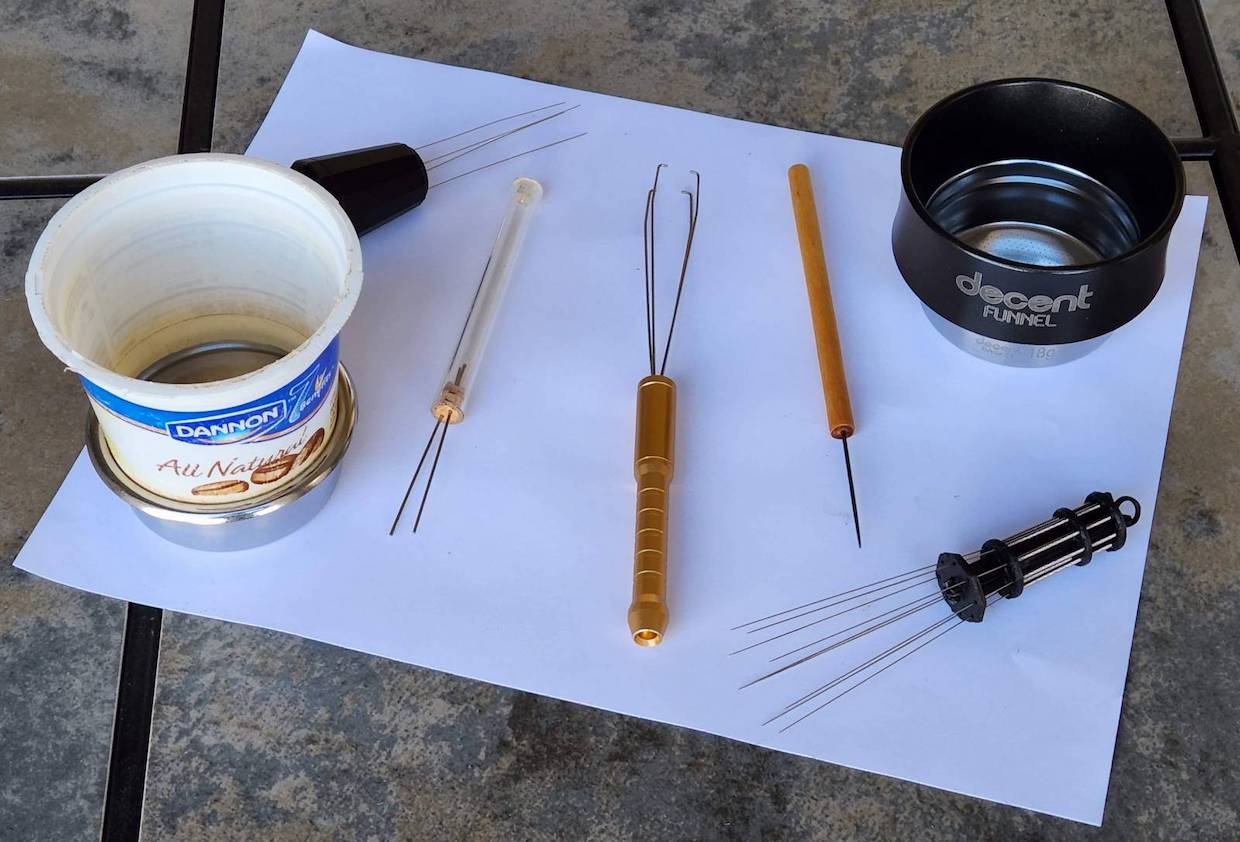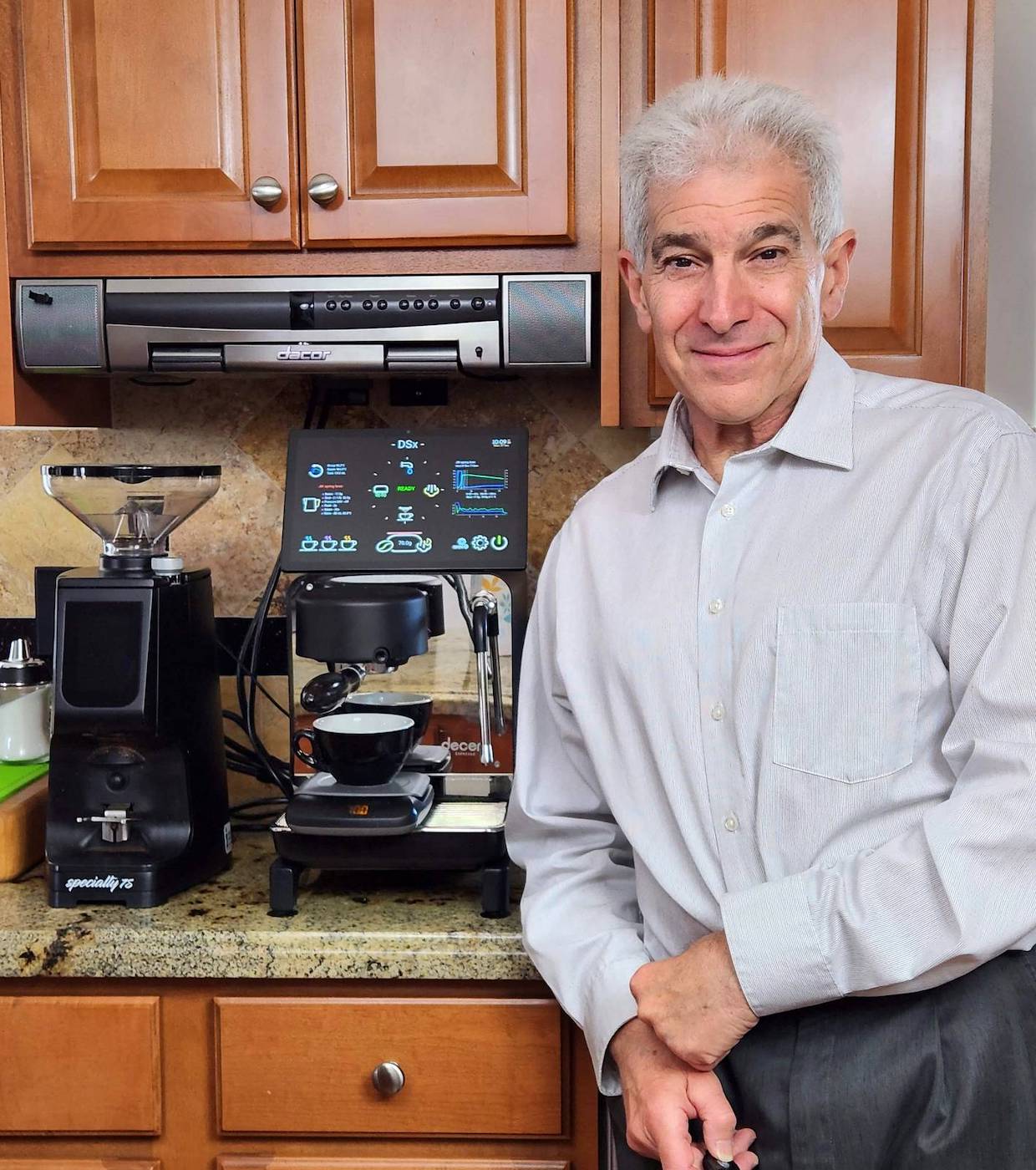
A variety of WDT tools, which can come in any number of shapes, sizes and needle configurations. Daily Coffee News photo by Howard Bryman.
Along with the recent boom in home espresso preparation has come an associated flood of accessories to support the craft, including many variations of something called a WDT tool.
WDT stands for Weiss Distribution Technique, an espresso preparation technique attributed to retired computer scientist and biochemistry PhD John Weiss.
The tool used to perform this technique typically involves an array of needles or other slim protrusions extending from a handheld piece. The tool is used to stir the freshly ground coffee in an espresso portafilter basket prior to tamping.
WDT is not a widely adopted practice behind fast-paced, high-volume commercial coffee bars. Yet for home and professional baristas in calmer settings, WDT is now a common and oft-recommended technique, with WDT tools proliferating all over the world.
This begs the questions, ‘Why are people stirring their espresso grounds?’ and ‘Who is John Weiss?’ Daily Coffee News went straight to the source to find out.
The WDT Espresso Method
WDT is simply the practice of using any thin but reasonably sturdy implement to stir, or “rake,” a pile of finely ground coffee inside a portafilter basket. This can involve either combing the surface of the pile or driving the needles more deeply through the bed.
The goals are to break down any clumps of ground coffee that may have resulted from grinding and to evenly distribute the coffee within the basket prior to compression by a tamper.
Whereas John Weiss originally used a single dissection needle to accomplish this task, modern WDT tools often use multiple acupuncture needles, or other slim metal needles within 0.1-0.5 millimeters in diameter.
While the optimal stirring pattern and stirring depth remain matters of continued discussion, the intended result is always a puck of uniform density, with uniform resistance to water, for an even and precise espresso extraction.
WDT History
It was around 2004 that John Weiss, then a computer science professor and a home espresso enthusiast living in South Dakota, first started tinkering with stirring his grounds. From his home in the Black Hills, he began to see images online of beautiful espresso extractions issuing from what was also then a recent breakthrough: the bottomless portafilter. He used a hole saw to create his own bottomless portafilter and started fixating on creating similarly lovely bottomless extractions at home.
“Initial struggles with channeling led me to the conclusion that good grinds distribution in the basket was a critical factor in pretty extractions,” John Weiss told Daily Coffee News. “After some trial and error, I began using a dissecting needle to stir grinds, with a cut-down yogurt cup as a funnel/shot collar to contain the mess.”
The dissection needle, a remnant from Weiss’ college days, was initially chosen simply because it was the closest thin implement at hand. In December 2005, Weiss shared information about his technique with the online community on a (no longer available) message board of CoffeeGeek.com. Later that month, he shared it again on Home-Barista.com, whose founder, Dan Kehn, adopted the technique, continued the public discussion and invited Weiss to post a tutorial.
“To my surprise, WDT met with significant skepticism within the espresso community,” Weiss recalled. “Grinds distribution seemed like an obvious improvement for home espresso, but the focus at the time was on surface distribution methods like Stockfleth’s and tamping techniques like Staub. Folks were ignoring fundamentals like dose and distribution.”
Espresso grinders were also more apt to produce clumpy grounds in those days, though the benefits of declumping and distribution are still applicable today.
“The WDT seemed like a low-hanging fruit for the home barista audience,” said Weiss. “I’m surprised that nobody suggested it sooner, and surprised that it generated so much controversy over the years. Now it’s mainstream. Go figure.”
WDT: The Man
Now retired and living near Phoenix, John Weiss grew up in the New York area before earning a bachelor’s degree in molecular biophysics and biochemistry from Yale University in 1974. That was followed by a PhD in Biochemistry from Vanderbilt University in 1980.
Following two years of postdoctoral research in neuroscience, Weiss switched gears to earn a master’s degree in computer science from Vanderbilt in 1984. He then went on to teach computer science, first at Virginia Commonwealth University and then at the South Dakota School of Mines and Technology in Rapid City. Weiss spent 35 years teaching various facets of computer science and has never worked in the coffee industry.
In his retirement, Weiss enjoys hiking and biking, traveling, playing guitar, reading and, of course, coffee. He continues to serve as a moderator on Home-Barista.com, follows trends in specialty coffee through reading and occasionally reviews products.
The good professor continues to tinker with the extractions for his daily cappuccinos, which involve a Decent Espresso DE1 machine and several espresso grinders, including a Mazzer Robur. Though Weiss no longer uses the dissection needle, he still prefers the pencil-like ergonomics of similar tools.
“These days I’m mostly using an inexpensive four-needle keycap puller that I found on Amazon,” said Weiss. “WDT tools with more, thinner needles and wine cork-shaped handles feel clumsy in my hand. And yes, I’m still using my old cut-down yogurt cup funnel. Perhaps the only idiosyncrasy in my espresso prep routine: I prefer dosing baskets outside the portafilter, and a lightweight plastic funnel works better than heavier commercial metal funnels.”
While the tools bearing his name now range in price online and internationally from a few bucks to over $50, Weiss does not harbor regrets about never seeking a patent or a product of his own design.
“I don’t have an entrepreneurial bone in my body, and never seriously considered commercialization,” said Weiss. “I wanted to give back to the coffee community, and I’m delighted to see WDT helping home baristas worldwide. Ironically, I’ve published 80+ peer-reviewed papers in scientific journals and conferences. But for better or worse, apparently WDT is my legacy.”
Does your coffee business have news to share? Let DCN’s editors know here.
Howard Bryman
Howard Bryman is the associate editor of Daily Coffee News by Roast Magazine. He is based in Portland, Oregon.
Comment
2 Comments
Comments are closed.









Interesting that 6 days earlier, Lance Hedrick posted a YouTube video: “WTF is WDT: History, Evolution, and Current Trends of the Weiss Distribution Technique”; both theatrical and informative.
Like Third Wave (etc.) Water – the homeopathy of espresso. File with the 300mpg carburetor and perpetual motion machines